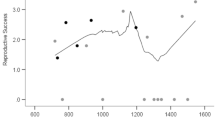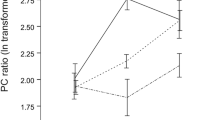Summary
Two terpenic constituents, E,E,-α-farnesene and E-β-farnesene, were found to be elevated in dominant male urine when compared to subordinate or control males. These two urinary compounds were absent in the bladder urine of males; however, they were the most prominent constituents of the preputial gland's aliquots. The results of a two-choice preference test, conducted on ICR/Alb subordinate males, gave a strong indication that these two terpenic constituents introduced into the previously attractive stimulus significantly discouraged prolonged investigations by male mice. The compounds, whether present in the urine matrix or water, rendered the stimulus with a quality behaviorally similar to the urine of dominant males. It appears that they may be synonymous with the previously described aversion signal produced by dominant males. We suggest that these compounds may play a wide-ranging role in the territorial marking behavior of male mice.
Similar content being viewed by others
References
DeFries, J. C., and McClearn, G. E., Am. Nat.104 (1970) 408.
Oakeshott, J. G., Oecologia15 (1974) 143.
Huck, U. W., Banks, E. M., and Wang, S. C., Behav. Neural Biol.33 (1981) 364.
Christian, J. J., Lloyd, J. A., and Davis, D. E., Rec. Progr. Horm. Res.21 (1965) 501.
Bronson, F. H., Bull. ecol. Soc. Am.47 (1966) 182.
Bronson, F. H., Stetson, M. H., and Stiff, M. E., Physiol. Behav.10 (1973) 369.
Chapman, V. H., Desjardins, C., and Bronson, F. H., Proc. Soc. exp. Biol. Med.130 (1969) 624.
Bronson, F. H., Q. Rev. Biol.54 (1979) 265.
Lombardi, J. R., and Vandenbergh, J. G., Science196 (1977) 545.
Jones, R. B., and Nowell, N. W., Physiol. Behav.11 (1973) 35.
Jones, R. B., and Nowell, N. W., J. Endocr.59 (1973) 302.
Mugford, R. A., and Nowell, N. W., Nature226 (1970) 967.
Rose, R. N., Bernstein, I. S., and Gordon, T. P., Psychosom. Med.37 (1975) 50.
McKinney, T. D., and Desjardins, C., Biol. Reprod.9 (1973) 370.
Harvey, S., Jemiolo, B., and Novotny, M., J. chem. Ecol.15 (1989) 2061.
Novotny, M., Harvey, S., Jemiolo, B., and Alberts, J., Proc. natl Acad. Sci. USA82 (1985) 2059.
Jemiolo, B., Alberts, J., Sochinski-Wiggins, S., Harvey, S., and Novotny, M., Anim. Behav.33 (1985) 1114.
Jemiolo, B., Harvey, S., and Novotny, M., Proc. natl Acad. Sci. USA83 (1986) 4576.
E,E-α-farnesene and E-β-farnesene were identified from their mass spectra and retention of authentic compounds through capillary gas chromatography. E,E-α-farnesene was synthesized (Negishi and Matushita, Org. Synth.62 (1984) 31–36) and E-β-farnesene was isolated from the oil of chamomile (Murray, K. E., Aust. J. Chem.22 (1969) 197–204; Sorn, F. et al., Coll. Trav. Chim. Tchec.14 (1959) 699–715; Sorn, F. et al. Coll. Czech. Chem. Commun.16 (1959) 626–638.
Jones, J. B., and Nowell, N. W., J. Endocr.60 (1974) 19.
Novotny, M., Lee, M. L., and Bartle, K. D., Chromatographia7 (1974) 333.
Schwende, F. J., Wiesler, D., Jorgenson, J. W., Carmack, M., and Novotny, M., J. chem. Ecol.12 (1986) 277.
Caroom, D., and Bronson, F. H., Physiol. Behav.7 (1971) 659.
Aron, C., Physiol. Rev.59 (1976) 229.
Lehninger, A. L., Biochemistry, 2nd edn, pp. 679–684. Worth Publishers, Inc., New York 1975.
Cavill, G. W. K., Williams, P. J., and Whitfield, F. B., Tetrahedron Lett.23 (1967) 2201.
Bowers, W. S., Nault, L. R., Webb, R. E., and Dutky, S. R., Science177 (1972) 1121.
Pickett, J. A., and Griffiths, D. C., J. chem. Ecol.6 (1980) 349.
Gibson, R. W., and Pickett, J. A., Nature302 (1983) 608.
Bailey, N. T. J., Statistical Methods in Biology, 2nd edn. John Wiley and Sons, New York 1981.
Author information
Authors and Affiliations
Rights and permissions
About this article
Cite this article
Novotny, M., Harvey, S. & Jemiolo, B. Chemistry of male dominance in the house mouse,Mus domesticus . Experientia 46, 109–113 (1990). https://doi.org/10.1007/BF01955433
Received:
Accepted:
Issue Date:
DOI: https://doi.org/10.1007/BF01955433




